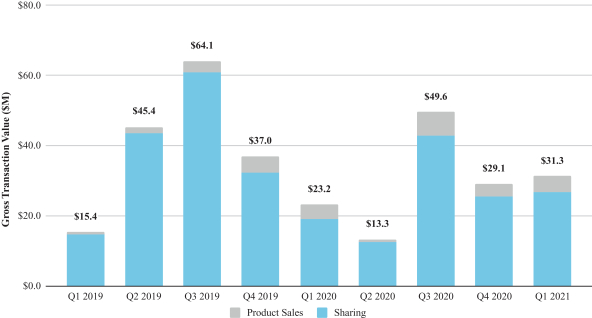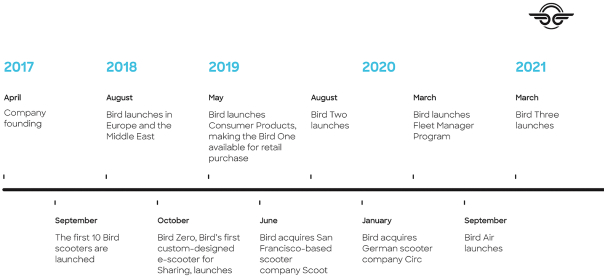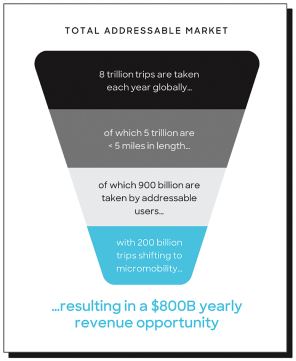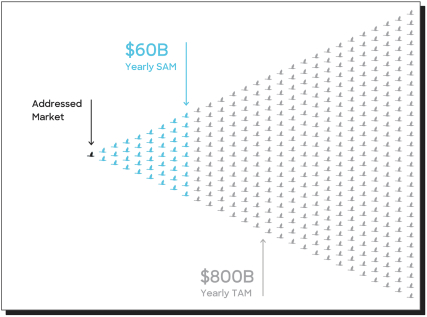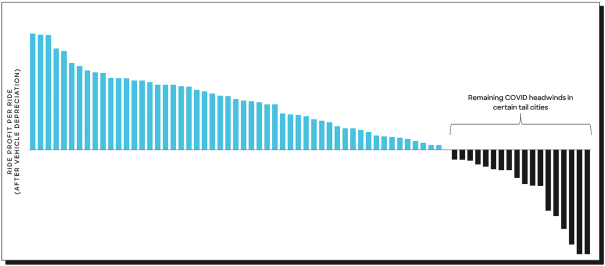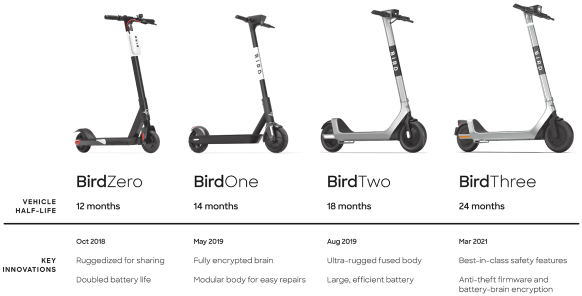The information in this preliminary proxy statement/prospectus is not complete and may
be changed. The securities described herein may not be sold until the registration statement filed with the U.S. Securities and Exchange Commission is declared effective. This preliminary proxy statement/prospectus is not an offer to sell these
securities and it is not soliciting an offer to buy these securities in any jurisdiction where the offer or sale is not permitted.
PRELIMINARY PROXY STATEMENT/PROSPECTUS
SUBJECT TO COMPLETION, DATED JULY 15, 2021
PROXY STATEMENT FOR
EXTRAORDINARY GENERAL MEETING OF SWITCHBACK II CORPORATION
PROSPECTUS FOR
271,894,672
SHARES OF CLASS A COMMON STOCK,
37,636,578 SHARES OF CLASS X COMMON STOCK, AND 11,875,000 WARRANTS OF BIRD GLOBAL, INC.
(AFTER THE DOMESTICATION MERGER DESCRIBED HEREIN)
The board of
directors of Switchback II Corporation, a Cayman Islands exempted company (“Switchback”), has unanimously approved the Business Combination Agreement, dated as of May 11, 2021 (the “Business Combination Agreement”), by and among
Switchback, Maverick Merger Sub Inc., a Delaware corporation and a direct wholly owned subsidiary of Switchback (“Merger Sub”), Bird Rides, Inc., a Delaware corporation (“Bird”), and Bird Global, Inc., a Delaware corporation and
wholly owned direct subsidiary of Bird (“Bird Holdings”), a copy of which is attached to this proxy statement/prospectus as Annex A.
Pursuant to the Business Combination Agreement, the business combination will be effected in two steps: (a) subject to the approval and
adoption of the Business Combination Agreement by the shareholders of Switchback, Switchback will reincorporate to the State of Delaware by merging with and into Bird Holdings (the “Domestication Merger”), with Bird Holdings surviving the
Domestication Merger as a publicly traded entity (such surviving entity, “New Bird,” and the time at which the Domestication Merger becomes effective, the “Domestication Merger Effective Time”) and becoming the sole owner of
Merger Sub; and (b) at least one business day, but no more than two business days, after the Domestication Merger Effective Time (the “Acquisition Closing Date”), Merger Sub will merge with and into Bird (the “Acquisition Merger”
and, together with the Domestication Merger and all other transactions contemplated by the Business Combination Agreement, the “Business Combination”), with Bird surviving the Acquisition Merger as a wholly owned subsidiary of New Bird.
At the Domestication Merger Effective Time, pursuant to the Domestication Merger: (a) each then-outstanding share of Bird Holdings
common stock, par value $0.000001 per share, shall be redeemed for par value; (b) each then-outstanding Class A ordinary share, par value $0.0001 per share, of Switchback (the “Class A Ordinary Shares”) will be canceled and
converted, on a one-for-one basis, into a share of Class A common stock, par value $0.0001 per share, of New Bird (the “New Bird Class A Common
Stock”); (c) each then-outstanding Class B ordinary share, par value $0.0001 per share, of Switchback (the “Class B Ordinary Shares”) will be canceled and converted, on a one-for-one basis, into a share of Class B common stock, par value $0.0001 per share, of New Bird (the “New Bird Class B Common Stock”) (with such shares of New Bird Class B Common Stock
thereafter converting, on a one-for-one basis, into a share of New Bird Class A Common Stock in connection with the Acquisition Merger as described below);
(d) each then-outstanding warrant of Switchback (the “Switchback Warrants”) will be assumed and converted automatically into a warrant to purchase one share of New Bird Class A Common Stock (the “New Bird Warrants”),
pursuant to that certain warrant agreement by and between Switchback and Continental Stock Transfer & Trust Company; and (e) each then-outstanding unit of Switchback, each consisting of one Class A Ordinary Share and one-fifth of one Switchback Warrant (the “Switchback Units”), will be canceled and converted into a unit of New Bird (the “New Bird Units”), each consisting of one share of New Bird Class A
Common Stock and one-fifth of one New Bird Warrant.
On the Acquisition Closing Date and
immediately prior to the effective time of the Acquisition Merger (the “Acquisition Merger Effective Time”), each then-outstanding share of Bird Preferred Stock and Bird Founders Preferred Stock (each as defined herein) will convert
automatically into a number of shares of common stock, par value $0.000001 per share, of Bird (“Bird Common Stock”) at the then-effective conversion rate as calculated pursuant to the certificate of incorporation of Bird (the
“Conversion”).
At the Acquisition Merger Effective Time, pursuant to the Acquisition Merger: (a) each then-outstanding
share of Bird Common Stock, including shares of Bird Common Stock resulting from the Conversion, but excluding shares of Bird’s outstanding restricted stock (“Bird Restricted Stock”), will be canceled and automatically converted into
the right to receive (i) (A) with respect to Travis VanderZanden, the number of shares of Class X common stock, par value $0.0001 per share, of New Bird (the “New Bird Class X Common Stock”) and (B) with respect to any
other persons who hold Bird Common Stock, the number of shares of New Bird Class A Common Stock, in each case, equal to the applicable exchange ratio (determined in accordance with the Business Combination Agreement and as further described in
this proxy statement/prospectus) and (ii) the contingent right to receive certain earnout shares; (b) each then-outstanding and unexercised warrant of Bird (the “Bird Warrants”) will automatically be assumed and converted into a
New Bird Warrant based on the exchange ratio and at an adjusted exercise price per share (determined in accordance with the Business Combination Agreement and as further described in this proxy statement/prospectus); (c) each then-outstanding and
unexercised option of Bird (a “Bird Option”) will be converted into (i) an option exercisable for shares of New Bird Class A Common Stock (a “New Bird Option”) based on the exchange ratio (determined in accordance with
the Business Combination Agreement and as further described in this proxy statement/prospectus) and (ii) the contingent right to receive certain earnout shares; (d) each then-outstanding award of Bird Restricted Stock will be converted
into (i) an award covering shares of New Bird Class A Common Stock (“New Bird Restricted Stock”) based on the applicable exchange ratio (determined in accordance with the Business Combination Agreement and as further described in
this proxy statement/prospectus) and (ii) the contingent right to receive certain earnout shares; and (e) each then-outstanding award of restricted stock units of Bird (a “Bird RSU Award”) will be converted into (i) an award
covering shares of New Bird Class A Common Stock (a “New Bird RSU Award”) based on the exchange ratio (determined in accordance with the Business Combination Agreement and as further described in this proxy statement/prospectus) and
(ii) the contingent right to receive certain earnout shares. At the Acquisition Merger Effective Time and in connection with the Acquisition Merger, each outstanding share of New Bird Class B Common Stock will be converted, on a one-for-one basis, into a share of New Bird Class A Common Stock and each New Bird Unit will separate into one share of New Bird Class A Common Stock and one-fifth of one
New Bird Warrant. See the section of this proxy statement/prospectus entitled “The Business Combination” for further information on the consideration being paid to the stockholders of Bird.
This proxy statement/prospectus covers 206,545,264 shares of New Bird Class A Common Stock (including Class A Ordinary Shares, New
Bird Class B Common Stock, and Bird Common Stock that will convert into shares of New Bird Class A Common Stock in connection with Domestication Merger or the Acquisition Merger, and shares issuable upon exercise or vesting of the New Bird
Warrants, New Bird Restricted Stock, New Bird Options, and New Bird RSU Awards), 33,454,736 shares of New Bird Class X Common Stock (including Bird Common Stock that will convert into shares of New Bird Class X Common Stock) to be issued
in connection with the Acquisition Merger, and 11,875,000 New Bird Warrants. In addition, up to an aggregate of 30,000,000 shares of New Bird Class A Common Stock, shares of New Bird Class X Common Stock, and/or shares of restricted common
stock of New Bird may be issued as additional merger consideration if certain share price thresholds are achieved within five years after the Acquisition Closing Date. The number of shares of New Bird Class A Common Stock and New Bird
Class X Common Stock that this proxy statement/prospectus covers represents the maximum number of shares that may be issued to holders of shares of Bird Common Stock, Bird Restricted Stock, Bird Warrants, Bird Options, and Bird RSU Awards in
connection with the Acquisition Merger (as more fully described in this proxy statement/prospectus), together with the shares issued or issuable to the existing holders of Class A Ordinary Shares, Class B Ordinary Shares, Switchback
Warrants, and Switchback Units in connection with the Domestication Merger.
The New Bird Class X Common Stock will have the same economic
terms as the New Bird Class A Common Stock, but the New Bird Class X Common Stock will be entitled to 20 votes per share compared to one vote per share for the New Bird Class A Common Stock. Therefore, following consummation of the Business
Combination, Travis VanderZanden will hold up to approximately 71.2% of the combined voting power of New Bird Class A Common Stock and New Bird Class X Common Stock. As a result, New Bird will be a “controlled company” within the meaning
of The New York Stock Exchange (“NYSE”) corporate governance standards. See “Management After the Business Combination — Controlled Company Exception” and “Beneficial Ownership of Securities.”
The Switchback Units, Class A Ordinary Shares and Switchback Warrants are currently listed on the NYSE under the symbols
“SWBK.U,” “SWBK,” and “SWBK WS,” respectively. The parties anticipate that, following the Business Combination, the New Bird Class A Common Stock and New Bird Warrants will be listed on the NYSE under the symbols
“BRDS” and “BRDS WS,” respectively, and the Switchback Units, Class A Ordinary Shares, and Switchback Warrants will cease trading on the NYSE and will be deregistered under the Securities Exchange Act of 1934, as amended, upon
the consummation of the Domestication Merger.
This proxy
statement/prospectus provides shareholders of Switchback with detailed information about the Business Combination and other matters to be considered at the extraordinary general meeting of Switchback. We encourage you to read this entire document,
including the annexes and other documents referred to herein, carefully and in their entirety. You should also carefully consider the risk factors described in the section entitled “Risk Factors” beginning on
page 22 of this proxy statement/prospectus.
NEITHER THE SECURITIES AND EXCHANGE COMMISSION NOR ANY STATE SECURITIES
REGULATORY AGENCY HAS APPROVED OR DISAPPROVED OF THE TRANSACTIONS DESCRIBED IN THIS PROXY STATEMENT/PROSPECTUS, PASSED UPON THE MERITS OR FAIRNESS OF THE BUSINESS COMBINATION OR RELATED TRANSACTIONS, OR PASSED UPON THE ADEQUACY OR ACCURACY OF THE
DISCLOSURE IN THIS PROXY STATEMENT/PROSPECTUS. ANY REPRESENTATION TO THE CONTRARY CONSTITUTES A CRIMINAL OFFENSE.
This proxy
statement/prospectus is dated , 2021, and
is first being mailed to Switchback’s shareholders on or about
, 2021.
